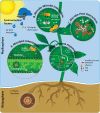Shaping the leaf microbiota: plant-microbe-microbe interactions
- PMID: 32910810
- PMCID: PMC8210630
- DOI: 10.1093/jxb/eraa417
Shaping the leaf microbiota: plant-microbe-microbe interactions
Abstract
The aerial portion of a plant, namely the leaf, is inhabited by pathogenic and non-pathogenic microbes. The leaf's physical and chemical properties, combined with fluctuating and often challenging environmental factors, create surfaces that require a high degree of adaptation for microbial colonization. As a consequence, specific interactive processes have evolved to establish a plant leaf niche. Little is known about the impact of the host immune system on phyllosphere colonization by non-pathogenic microbes. These organisms can trigger plant basal defenses and benefit the host by priming for enhanced resistance to pathogens. In most disease resistance responses, microbial signals are recognized by extra- or intracellular receptors. The interactions tend to be species specific and it is unclear how they shape leaf microbial communities. In natural habitats, microbe-microbe interactions are also important for shaping leaf communities. To protect resources, plant colonizers have developed direct antagonistic or host manipulation strategies to fight competitors. Phyllosphere-colonizing microbes respond to abiotic and biotic fluctuations and are therefore an important resource for adaptive and protective traits. Understanding the complex regulatory host-microbe-microbe networks is needed to transfer current knowledge to biotechnological applications such as plant-protective probiotics.
Keywords: Biofilm; innate immunity; microbe–microbe interaction; microbial colonization; phyllosphere; quorum sensing.
© The Author(s) 2020. Published by Oxford University Press on behalf of the Society for Experimental Biology.
Figures

References
-
- Adame-Álvarez RM, Mendiola-Soto J, Heil M. 2014. Order of arrival shifts endophyte–pathogen interactions in bean from resistance induction to disease facilitation. FEMS Microbiology Letters 355, 100–107. - PubMed
-
- Aragón W, Reina-Pinto JJ, Serrano M. 2017. The intimate talk between plants and microorganisms at the leaf surface. Journal of Experimental Botany 68, 5339–5350. - PubMed
-
- Arnaud D, Hwang I. 2015. A sophisticated network of signaling pathways regulates stomatal defenses to bacterial pathogens. Molecular Plant 8, 566–581. - PubMed
-
- Arnold AE, Henk DA, Eells RL, Lutzoni F, Vilgalys R. 2007. Diversity and phylogenetic affinities of foliar fungal endophytes in loblolly pine inferred by culturing and environmental PCR. Mycologia 99, 185–206. - PubMed
Publication types
MeSH terms
LinkOut - more resources
Full Text Sources
Research Materials

